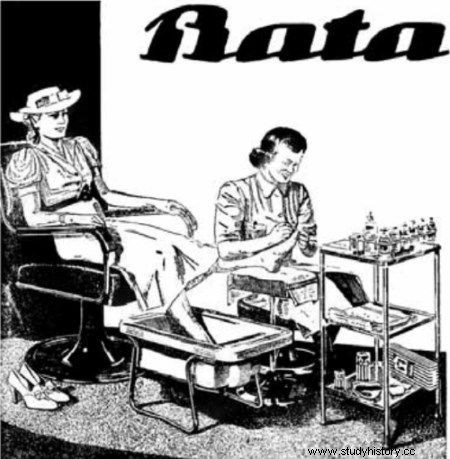As long, heavy skirts gave way to leg-revealing dresses, the latter took center stage. The feet had to be cared for more than ever before. How did the inhabitants of pre-war Poland do it?
When, with the revolution in women's fashion, ladies began to show the ankle first, then even the entire calf and wear sandals, a niche appeared on the market. A certain darting businessman dealing in the sale of shoes decided to develop it very quickly. According to doctor Franciszek Račansky, who worked before the war as an orthopedic doctor at the hospital in Zlin, Jan Bata decided to change his shops into full-fledged… leg care facilities. The range of services offered was to satisfy even the most demanding customers.

After decent pre-war pedicure, each shoe will be comfortable…
It was a real revolution in the Polish footwear world. The staff was educated in the field of foot care so that employees could choose the right footwear and remedy any hygiene and orthopedic problems. Managers also began to be expected to do much more than just a passion for business.

Pedikure in Bata according to the company's promotional materials.
According to the authors of "Scientific Foot Care" - a brochure commissioned by the Bata company in 1935 - it was equally important ... to master the art of pedicure. Even the manager of each store was supposed to serve at least twenty customers a week! Anyway, it is hardly surprising, since according to the words written in the booklet:
The need for foot care and massage is much greater than the need for footwear, although it seems unbelievable to us today. Every person needs care, combined with a thorough massage, at least once a month - as long as their feet are normally developed.
If it has any defects on its feet, a treatment with a bath and massage is needed at least once a week.
What was a professional salon like before the war?
The pre-war professional pedicure was very similar to what we can treat ourselves to today in a beauty salon. All stages of the treatment were presented in detail in Bata's promotional materials. Even the question of the proper appearance of the person making it has been dealt with! A good pediatrician always has clean hands, without rings, and nails are neatly trimmed. The pediatrician has a white coat and decent and clean shoes - we read brochures on the cards.
Neatness is one thing. However, the specialist also had to be able to properly prepare his workplace. All the necessary accessories were to be at hand and the tools disinfected. Additionally, the employee should have a well-stocked rack with an assortment of stockings, socks, insoles and other aids. So with everything that could be sold to a relaxed client ...
The first stage of the procedure has not changed since the times of our grandmothers and great-grandmothers. Eighty years ago, it was recommended that the procedure should be started by thoroughly washing the feet and soaking them in water with the addition of an odor remover. This was to take up to ten minutes.

Whip. A Czech company, but in Poland it had - according to the poster - as many as 1700 employees.
In a completely modern textbook for people studying the profession of a cosmetic service technician - "Hands, feet, body" from 2014 - the beginning of the procedure looks similar. The authors emphasize that the bath is important for hygiene and for facilitating the removal of callous epidermis. At the same time, disinfection and soaking of the feet gives comfort to the client, who often shows up in the salon after a full day's work. Showing tired and sweaty feet can be just embarrassing for him.
A moment of relaxation
Before the war, care was taken for the salon's guest to relax properly. However, it was primarily about creating… an appropriate atmosphere for trade. For the procedure, the stockings or socks had to be removed. And it's hard to find a more convenient time to talk about the stocking assortment. Warm water, in which the person undergoing pedicure kept their legs, massage the feet and the impression of unusual pampering made the vision of putting on new stockings or clean socks on the feet almost a compulsory thought!
The pedicurist was also required to examine the client's feet (and his shoes) so that he could diagnose the problems he was experiencing. It was necessary to pay attention to calluses and corns. Here, Bata's pediatrician salesman had a chance to show off in the sale of orthopedic accessories. They may not have been doctors, but they still had a selection of rubber insoles (allegedly) supporting a flat foot. The assortment also included, for example, joint protectors.

Bata's first, pre-war salon in Kielce.
In the second stage of the procedure, the nails were cleaned. The third was to remove all calluses, and the fourth and last was to massage the feet. In a modern study, the junction points are roughly the same, although there are a few minor points that the 1935 mini-manual did not include. These include, for example, the removal of the epidermal border and, if necessary, the cutting of the cuticles.
For the client to come back
It was extremely important for the pediatrician to perform his work carefully, with concentration, skill, hygiene and painlessness. It was also necessary to pay attention to the signs of disease on the feet and, if necessary, send the delinquent to a specialist. Everything for the benefit of consumers! After all, a satisfied customer is a regular customer. On the other hand, the pedicurist's carelessness could have ended very badly for himself.
Crossing the boundaries of a pedicurist's activity usually ends dangerously, leads to consequences for which the pedicurist is sometimes prosecuted and punished with a financial penalty for treatment and pain, as well as for the loss of the lost earnings for the client's inability to work.
Franciszek Račansky made threats with utmost determination. He did not forget to emphasize that in the event of complications, the company ... always washes its hands. Each pedicurist is personally responsible for his / her activities - he said. And although several decades have passed, at least the approach of large corporations to customer responsibility has not changed at all.
Sources:
The article was based on the sources and materials collected by the author while working on the publication "Beauty without preservatives. Beauty secrets of our great-grandmothers ”. Full bibliography in the book.
